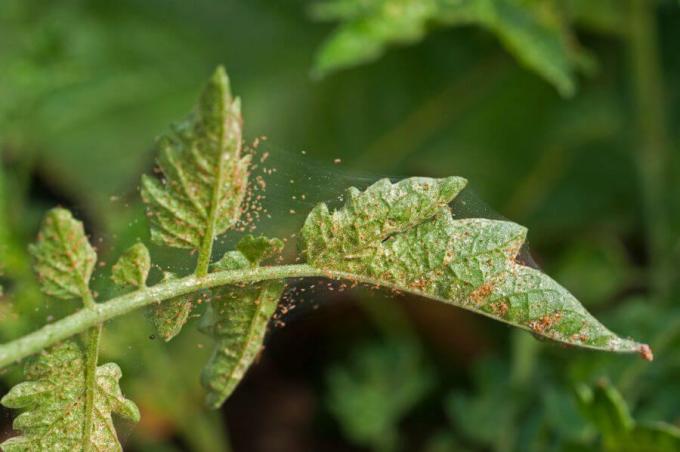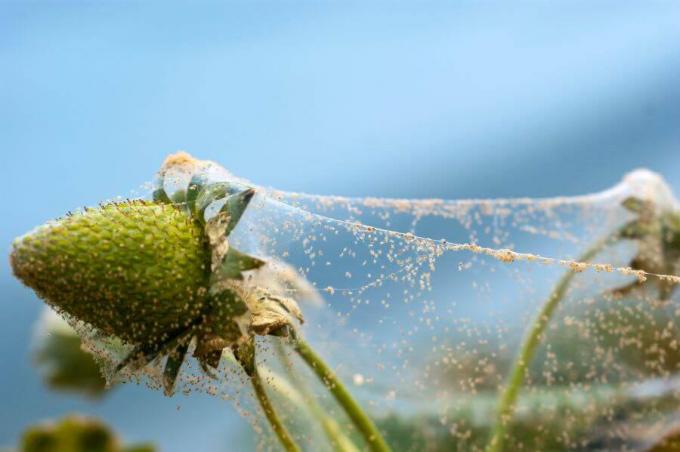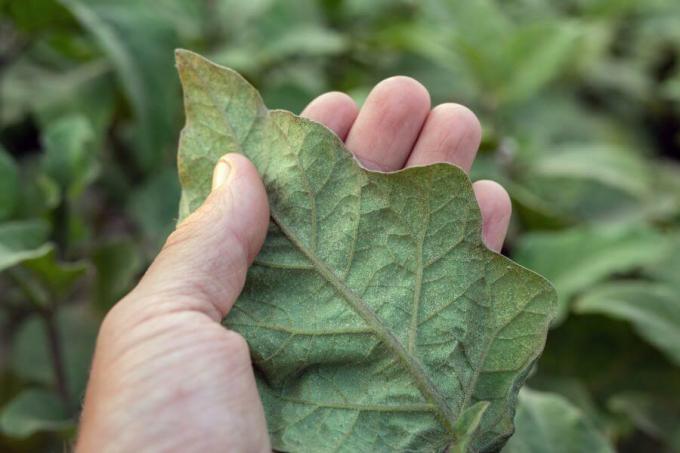Spider mite infestation is a nightmare for many gardeners. We show how you can recognize the damage and how you can fight the annoying spider mites naturally and with home remedies.
Every hobby gardener who has had an unloved visit from spider mites knows how stubborn the little arachnids can be. Whether roses (pink), Fruit trees, the oleander (Nerium oleander) in the garden or orchids (Orchidaceae), Ficus (Ficus benjamina) or the citrus tree (Citrus) on the windowsill - spider mites can attack a wide variety of plants. Straight tomatoes (Solanum lycopersicum), Cucumber (Cucumis sativus) and other vegetables grown in the greenhouse are popular targets for the tiny mites. If the spider mites appear only in small numbers, they usually go unnoticed. In dry, warm or hot weather, the number of spider mites increases rapidly and the animals quickly become a real problem.
contents
- Recognize spider mites
- Damage caused by spider mites
-
Fight spider mites
- Fight spider mites naturally
- Fight spider mites with home remedies
- Fight spider mites with beneficial insects
- Prevent spider mites
Recognize spider mites
Spider mites (Tetranychidae) are arachnids and accordingly have eight legs. The two rear pairs of legs are rather inconspicuous, whereas the front pairs are used more and are clearly visible. Externally, the mites can be very different. The color spectrum of the adult animals ranges from yellow to green to red, which is where the common name "red spider" comes from. In Germany, the common spider mite (Tetrnychus urticae) and the fruit tree spider mite (Panonychus ulmi) known as the most common plant-damaging spider mites. At well under a millimeter, the tiny animals are so small that they are difficult to see with the naked eye. Only when the infestation is advanced can small webs of mites be seen on petioles or branches. The small spider mites can be seen on these webs with the help of a magnifying glass. Spider mite infestation is particularly noticeable on the web and the damage caused by the spider mites.
Tip: By spraying the plant with water using an atomizer, the webs become more visible because small droplets stick to them.
Damage caused by spider mites
Unlike aphids, which prick the ducts, the spider mites only suck out individual leaf cells, which creates characteristic point-like lightening. The lightening on leaves or flowers spreads as the infestation continues. This can lead to deformed shoot tips or to the drying up of infected parts of the plant. In addition, webs with a large number of small spider mites can be seen.

Fight spider mites
Even if spider mites are very small and actually don't look particularly resilient: These animals are very stubborn! The spider mites not only weaken the plant and make it look extremely unsightly, but can also transmit plant viruses. It is also possible that they affect a large number of different plants, allowing them to spread quickly. It is therefore particularly important for this pest to recognize an infestation early on and to take immediate control measures to prevent it from spreading.
The first step in an identified infestation should be to isolate the plant, if possible. In this way you can avoid encroaching on neighboring plants.
Fight spider mites naturally
We advise against the use of synthetic pesticides, especially in the home garden or in living spaces, as these generally have a high potential for damaging beneficial insects in the garden. In addition, spider mites are resistant to some synthetic active ingredients, or the use of these agents is not recommended in order not to promote resistance. Biological preparations are available on the market, but many of them do not have a systemic effect. Therefore, multiple applications are required, which can be harmful to both the environment and the plant. Some pesticides contain active ingredients from the group of pyrethrins, which are of plant origin but can harm beneficial insects in your garden. We therefore recommend that you avoid these products. Biological agents based on pure rapeseed oil are environmentally friendly, but require thorough and repeated treatment. Preparations based on potash soap are also environmentally friendly, but repeated treatment is necessary here too.

Summary: This is how you can fight spider mites naturally
- If possible: isolate the infected plant to prevent it from spreading.
- Synthetic agents only work to a limited extent due to their resistance and are harmful to the environment.
- Biological preparations based on rapeseed oil or potash soap are effective, but require repeated use.
Fight spider mites with home remedies
Home remedies for spider mites can only be used to a very limited extent. If it is a plant in the open, you should remove particularly badly infested shoot tips or parts of plants from pruning-compatible plants. Since spider mites do not like moisture, a lot can be achieved with a slight infestation by daily rinsing the entire plant with the garden hose or in the shower.
Another home remedy for spider mites is to put a plastic bag over affected houseplants to increase the humidity. However, the air below it can heat up so much that the infected plant can also be seriously damaged. We therefore advise you to leave the plastic bag over the plant for only four days and, after a two-day break, to put the bag over the plant again for four days. You can also put an infected houseplant outside when it rains in summer.

Last but not least, the use of a water-oil emulsion with rapeseed oil promises to fight the spider mites. To do this, 70 milliliters of water are mixed with 30 milliliters of oil and whipped vigorously so that a white emulsion is created. This is then applied to the whole plant, including the underside of the leaf. But be careful: Shake the bottle repeatedly during the process so that the components do not separate. Unfortunately, many plants do not tolerate treatment with rapeseed oil very well, as it loosens the protective cuticle of the leaves. It is therefore better to use rapeseed oil as a remedy against spider mites only in the evening, when the sun is not shining as strongly. Repeat the application a maximum of three times in order not to weaken the plant too much.
If this measure does not work within a week, you should use an organic pesticide.
Summary: home remedies for spider mites
- Isolate infested plants if possible
- Remove infected parts of the plant if possible
- Spray the infected plant with water every day
- Put a plastic bag over the infested plant to increase the humidity underneath
- Put house plants in the rain in summer
- Prepare a spray mixture from 70% water and 30% rapeseed oil; treat plants a maximum of three times with it
Fight spider mites with beneficial insects
In the event of an infestation by spider mites, beneficial insects can also be used. Predatory mites like Phytoseiulus persimilis or gall midges like Feltiella acarisuga can help you keep the pests under control. The use of predatory mites is especially useful in the greenhouse and in the house, where spider mites also cause the greatest damage. There the beneficial organism cannot migrate so quickly and even if the name “predatory mite” appears dangerous, the animals are not dangerous for humans. In the field it makes more sense to encourage naturally occurring predatory mites through a natural garden design. While you are using beneficial insects against spider mites in a targeted manner, you should not use pesticides, as these could harm the beneficial insects.

Prevent spider mites
Spider mites can be resistant to some pesticides, which makes preventive measures particularly interesting. In the garden, the risk of spider mite infestation is particularly high in dry weather and hot temperatures because the animals prefer this weather. You can prevent spider mites in the following ways:
- Beneficial insects like gall mosquitoes can now help you keep the pests under control. Through natural flower beds with blooming herbs such as chamomile (Matricaria chamomilla), attract gall mosquitoes and other beneficial insects. A flowering meadow or tubs with beneficial organism-promoting flowering plants can easily be made with special mixtures such as ours Plantura beneficial insect magnet invest. We also recommend that you pay attention to plant protection measures that are gentle on beneficial insects in the event of a pest infestation so as not to harm your little helpers.
- If it is too high Nitrogen fertilization your plants are particularly susceptible to spider mites. We therefore recommend cautious nitrogen and organic fertilizers. With our Plantura organic fertilizers you can supply your plants with nutrients as required without making them susceptible to pests.
- In greenhouses you can use the Influence of temperature and humidity avoid severe infestation. You should make sure that the humidity does not drop too much and the temperature must not rise too high. Spider mites develop extremely quickly at around 30 ° C and in as dry an air as possible.
- In the house and straight to the Winter season the spider mite is also a problem: You should be particularly vigilant when you bring potted plants into the house to overwinter. Carefully examine the plants to be overwintered for spider mites. In winter, when dry, warm heating air prevails in the apartment, spider mites can multiply optimally.
How you targeted Predatory mites can be used against spider mites or against thrips, you can find out in our special article.



